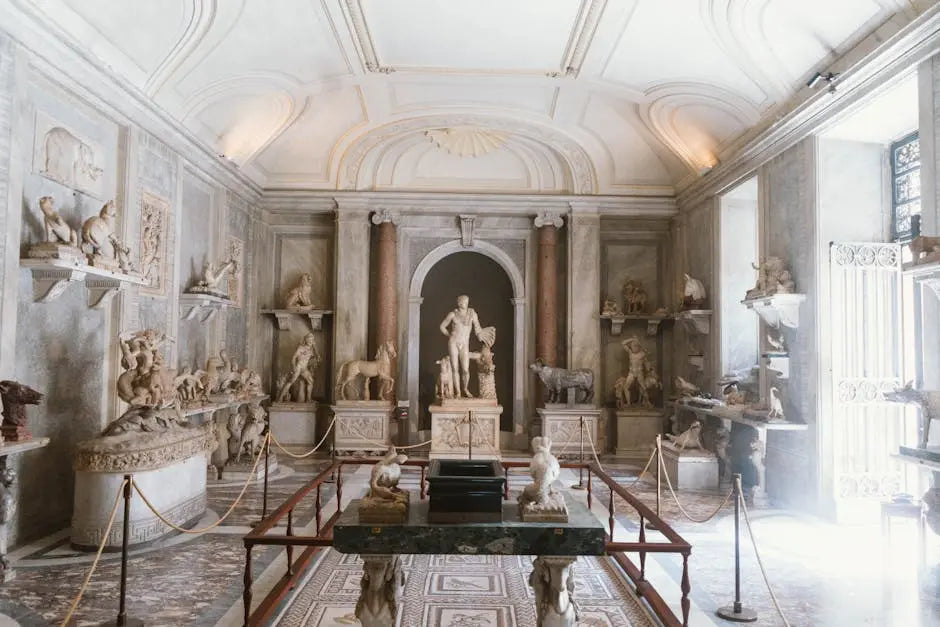My Cart
Your Cart is Currently Empty
FREE SHIPPING ON ALL ORDERS ABOVE $500


Figure sculpture has long served as a lens through which we can view and understand cultural moments. Through the nuanced expression of human form, artists capture the essence of their time, offering a unique reflection on societal values, beliefs, and transformations. In this blog, we’ll explore how these sculptural masterpieces have captured the spirit of different eras.
Throughout history, figure sculptures have been used to depict myths and gods, embodying the spiritual and cultural beliefs of ancient civilizations. These sculptures offer a glimpse into the realms of mythology, allowing us to understand the values and priorities of these societies.
In ancient Greece, for instance, the depiction of deities in human-like sculptures reflected the culture’s emphasis on anthropomorphic qualities in their gods. This practice not only highlights their sophisticated understanding of divine attributes but also shows how they revered and connected with these mythological figures on a human level. Such artistic expressions have informed our understanding of how earlier societies interpreted their world through religious lenses.
Moving beyond the West, consider the rich tradition of figure sculptures in Hindu temples, where intricate carvings of gods and goddesses narrate the mythological epics of the Ramayana and Mahabharata. These sculptures embody faith and devotion, revealing much about the social and religious structures of the time. Like in Greece, in these cultures, art became a conduit for religious experience, making mythology accessible and relatable to the common people.
Sculptors have often used their craft to mirror the everyday experiences of individuals within their society. By exploring common human themes like love, war, and daily life, they provide a tangible link to the past, reflecting both universal and specific cultural narratives.
The works of Auguste Rodin, for example, famously encapsulate the emotional intensity of human interactions. Through pieces like ‘The Kiss’ and ‘The Thinker’, Rodin expressed the intricacies of human emotion, capturing moments that resonate with viewers across different cultures and times. His ability to sculpt these silent yet powerful emotions reveals the timeless nature of human experiences.
Similarly, the Terracotta Army of China’s Qin Dynasty is a testament to the blend of individuality and uniformity, reflecting the society’s hierarchical structure and martial prowess. Each figure, unique in features and expression, symbolizes the emperor’s might, immortalizing the era’s socio-political landscape through detailed craftsmanship.
Figure sculpture has played a pivotal role in the evolution of art, often at the forefront of revolutions that defy traditional conventions. These sculptures not only capture the zeitgeist of the times but also challenge established notions of beauty and form, contributing to new artistic movements.
During the Renaissance, artists broke away from rigid medieval conventions, embracing realism and classical humanism. Sculptors like Michelangelo breathed life into marble, as seen in his ‘David’, set against political context. This marked not just a return to classical ideals but also a monumental shift toward envisioning the human body as a celebration of divine beauty and intellect.
In times of social upheaval and political change, figure sculptures have been used to critique or support movements. These artworks serve as potent symbols of resistance or endorsement, providing commentary on the shifting dynamics within societies.
The controversial ‘Comfort Women’ statues in various parts of the world are poignant examples of how figure sculpture can address historical injustices. They not only commemorate the suffering of women during wartime but also serve as potent reminders of the need for accountability and healing in our societies.
Contemporary sculptures often delve into themes of identity, personal expression, and cultural diversity. By highlighting the complexities of individual and group identities, sculptors contribute to the conversation about gender, race, and personal freedom.
The work of artists like Yinka Shonibare, who uses richly patterned textiles to dress his Victorian-era figures, offers a nuanced critique of colonialism and globalization. His sculptures challenge the viewer to consider the intersections of identity and cultural power, making his work incredibly relevant in today’s world.
Figure sculptures are often used to commemorate significant historical events, serving as lasting reminders of key moments in history. These works allow communities to connect with their past, honoring shared experiences and memories.
Consider the Vietnam Veterans Memorial in Washington D.C., a stark yet solemn tribute to those who served during the conflict. The reflective surface and names etched into the wall create a dialogue between the past and the present, prompting visitors to reflect on the complexities of war and memory.
With the advent of new materials and technologies, sculptors are pushing the boundaries of traditional techniques. These innovations are not only transforming the aesthetics of sculpture but also changing its interaction with contemporary culture, ensuring its relevance in modern times.
From using digital tools for precision carving to incorporating multimedia elements, modern sculptors are crafting experiences that resonate with today’s audiences. Artists like Antony Gormley utilize modern materials to create installations that invite interaction and introspection, blurring the lines between viewer and art in unprecedented ways.